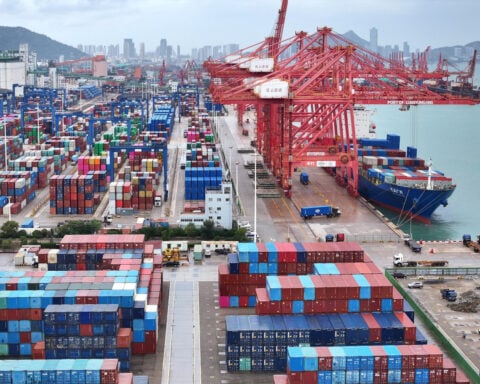BANGKOK (AP) — The mayhem that swept across world markets this week was partly caused by a market strategy known as the “carry trade.”
Japan’s benchmark Nikkei 225 plunged 12.4% on Monday and markets in Europe and North America suffered outsized losses as traders sold stocks to help cover rising risks from investments made using cheaply financed funds borrowed mostly in Japanese yen.
Markets recovered much of their losses on Tuesday. But the damage lingers.
They were jolted by a combination of factors, including dread of a possible recession in the United States, the world's largest economy, and worries that technology shares have shot way too high this year.
But the scale of the declines was exaggerated by the rush to sell U.S. dollars due to carry trade deals that had helped drive markets to record levels.
Carry trades involve borrowing at low cost in one currency to achieve higher returns from investments in another currency. One of the most recent examples has been to borrow Japanese yen, expecting the currency to remain cheap against the U.S. dollar and for Japanese interest rates to remain low. The borrowed funds would then be invested in U.S. stocks and Treasury bonds in anticipation of a higher return.
The key factor behind a carry trade is a difference in interest rates. The Bank of Japan has kept interest rates at or near zero for years, trying to encourage more spending and spur economic growth. Last week, it raised its main interest rate from nearly zero. Higher interest rates tend to boost the value of a nation's currency, and the Japanese yen surged against the U.S. dollar. Traders scrambled to sell higher risk, dollar-denominated assets to cover suddenly higher borrowing costs, plus losses from foreign exchange rate changes and losses in asset values as share prices plunged. Also, hedge funds that conduct carry trades use computer models to help maximize their returns versus their risks. They needed to sell shares to maintain acceptable risk profiles.
Carry trades tend to make the most sense when foreign exchange rates are relatively stable and investors can tap into higher yielding market opportunities, like the recent runups of stock prices in places like the United States. The recent market upheavals obliged traders to cover their debts by buying yen and other carry trade currencies and selling relatively more of the higher risk assets they bought under more favorable conditions. Also, carry trades are very lucrative when stocks or other investments are rising, but losses can snowball when thousands of traders are pressured to sell stocks or other assets all at once. “A massive global carry trade unwind was the spark that lit the fuse for this market Armageddon," Stephen Innes of SPI Asset Management said. “One defining characteristic of these self-perpetuating market melts is the vicious cycle where a sell-off increases realized volatility.”
The gap between the main interest rate in Japan, now at 0.25%, and the Federal Reserve’s benchmark rate of 5%-5.25% is still wide but is likely to narrow as the Fed cuts rates and Japan raises its rates. Financial markets appeared to have calmed Tuesday, with Japan's Nikkei 225 index gaining 10.2% and other markets mostly higher. Analysts are divided over whether this bout of volatility in the markets has passed or if there is more to come. Regardless, carry trades have been used for decades. They contributed to a meltdown in Iceland's financial sector in 2007-2008 where investors borrowed in yen or Swiss francs to take advantage of high Icelandic interest rates. During this latest market upset, Mexico, another focus of the yen carry trade, has seen its peso fall more than 6%. The popular but potentially complicated trading strategy is likely to remain a wild card for investors, especially in times of high market volatility.

 Russia arrests 4 suspects accused of plotting to kill top military officers on Ukraine's orders
Russia arrests 4 suspects accused of plotting to kill top military officers on Ukraine's orders
 Azerbaijan observes day of mourning for air crash victims as speculation mount about its cause
Azerbaijan observes day of mourning for air crash victims as speculation mount about its cause
 Pope opens special 'Holy Door' for Catholic Jubilee at Rome prison
Pope opens special 'Holy Door' for Catholic Jubilee at Rome prison
 Kazakhstan's senate chief: cause of Azerbaijan Airlines plane crash unknown for now
Kazakhstan's senate chief: cause of Azerbaijan Airlines plane crash unknown for now
 Japan's Nippon Steel extends closing date for U.S. Steel acquisition
Japan's Nippon Steel extends closing date for U.S. Steel acquisition
 BYD contractor denies 'slavery-like conditions' claims by Brazilian authorities
BYD contractor denies 'slavery-like conditions' claims by Brazilian authorities
 China revises up 2023 GDP to $17.73 trln, rules out impact on 2024 figure
China revises up 2023 GDP to $17.73 trln, rules out impact on 2024 figure
 Durant and Beal score 27 points each, Suns beat Nuggets 110-100 to close out Christmas slate
Durant and Beal score 27 points each, Suns beat Nuggets 110-100 to close out Christmas slate








